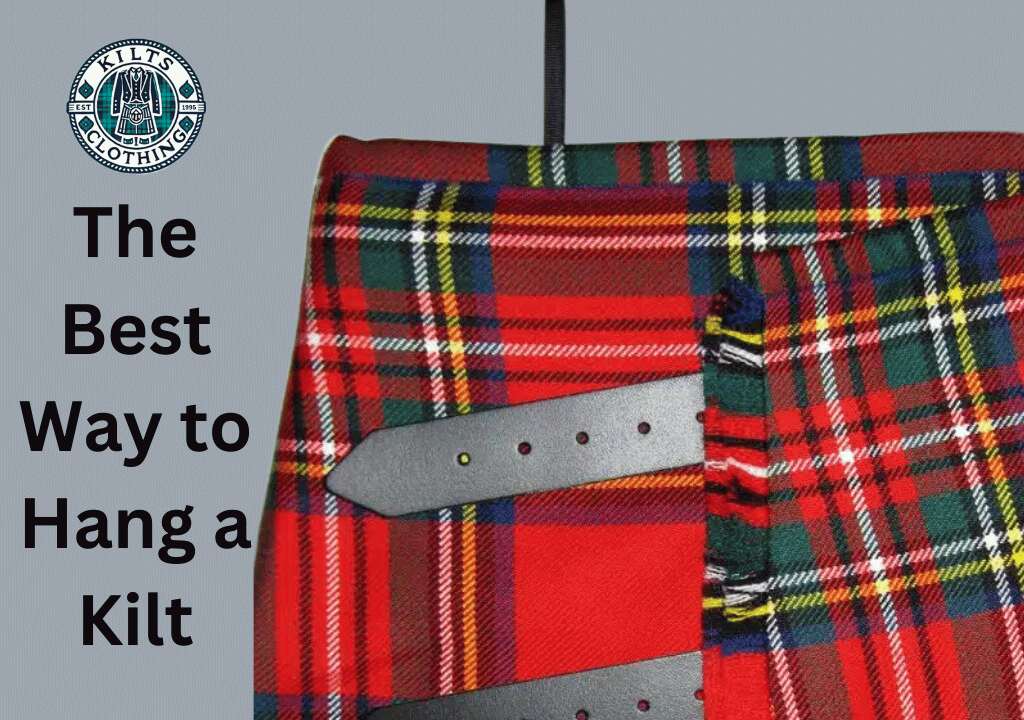The Best Way to Hang a Traditional Kilt

Introduction to Kilt Storage
Kilts, whether traditional kilt or utility, are more than just garments—they represent a rich cultural heritage. Proper kilt storage is essential to preserving the garment's structure, wrinkles, and overall appearance. Unfortunately, many kilt owners make common mistakes during storage that can lead to irreversible damage.
This guide will walk you through the best practices for storing your kilt clothing, ensuring it remains in excellent condition for years. By following these tips, you can confidently wear your kilt whenever the occasion arises, knowing it has been well cared for and preserved.
Understanding the Anatomy of a Kilt
To store a traditional kilt clothes properly, it's essential first to understand its unique anatomy. Kilts are known for their carefully crafted pleats, a defining feature requiring meticulous care to maintain their sharpness and structure. Traditional kilts are often made of wool, which requires different care compared to modern utility kilts that might use more durable, synthetic materials.
Understanding your kilt's specific material and pleating style will guide you in choosing the most appropriate storage methods. This knowledge ensures the kilt's longevity and preservation, allowing it to remain a cherished garment for years to come.
How to Hang a Kilt Properly
Hanging a cloth kilt correctly is essential to preserve its structure and appearance. Begin by ensuring the kilt is clean and wrinkle-free; light steaming can help remove any creases that might have formed. Lay the kilt flat and carefully align the pleats, ensuring they are straight and even.
Attach the kilt to a hanger by the waistband using a kilt hanger with clips, ensuring the clips are positioned evenly to avoid pulling or distortion of the fabric. Once the kilt is properly attached to the hanger, store it in a cool, dry place with good ventilation, such as a wardrobe. This will help prevent the formation of mold and mildew, keeping the kilt in pristine condition.
Choosing the Right Kilt Hanger
Selecting the appropriate traditional kilt hanger is crucial to maintaining the integrity of your kilt. There are several types of hangers available, each offering specific benefits tailored to different storage needs.
Types of Kilt Hangers
- Standard Kilt Hangers: These are basic hangers with clips that hold the kilt securely, making them a good basic option.
- Kilt Hangers with Clips: Particularly effective in maintaining the pleats, ensuring the kilt hangs evenly without causing distortion.
- Cedar Kilt Hangers: Provide sturdy support and natural moth-repelling properties, especially for woolen kilts.
When choosing a hanger, ensure it is wide enough to support the entire width of the kilt, preventing the wrinkles from stretching or distorting.
Storing a Kilt in Different Conditions
Different storage environments require different approaches to ensure your kilt remains in top condition. Hanging is generally preferred for daily storage, as it helps maintain the pleats and overall shape of the kilt. However, there are situations, such as during travel or when space is limited, where folding may be necessary.
Folding and Long-Term Storage
- Folding: If you need to fold the kilt, do so along the pleat lines and store it in a breathable kilt storage bag to protect it from dust and other potential damage.
- Long-Term Storage: A specialized kilt storage bag protects against dust, moths, and moisture. Ensure the bag is made of breathable materials, such as cotton, to prevent condensation buildup, which can damage the fabric over time.
 Preserving Kilt Pleats
Preserving Kilt Pleats
To preserve the pleats of your kilt, always use a kilt hanger specifically designed to support them, keeping them crisp and well-defined. When folding the kilt, follow the pleat lines carefully to avoid flattening them. For added protection, place tissue paper between the folds to help maintain the pleats' shape during storage.
It's also important to regularly check the wrinkles, even while the kilt is in storage, to ensure they remain aligned and in good condition. Lastly, always store the kilt in a cool, dry place to prevent moisture from distorting the pleats.
Moth Protection and Kilt Preservation
Protecting your kilt from moth damage is crucial, especially if your kilt is made from wool. Cedarwood rings or hangers are an excellent natural option for repelling moths, as cedar's natural oils deter these pests without harsh chemicals. This method protects the fabric and imparts a pleasant scent to your storage space.
Chemical-free maintenance is always preferable, as chemicals like mothballs can harm the fabric over time. In addition to using cedar products, regularly airing out your kilt can also help keep moths away and maintain their freshness. Ensuring that your storage area is clean, dry, and well-ventilated further contributes to the overall preservation of your kilt, keeping it in optimal condition.
Utility Kilts vs. Traditional Kilts: Does Storage Differ?
Storing utility kilts to traditional kilts involves some differences, primarily due to the materials used in their construction. Utility kilts, made from durable, modern fabrics, are generally more resistant to damage from moths and moisture. However, they still require proper hanging to maintain their shape and structure.
Often made from wool, traditional kilts are more susceptible to moth damage and require additional care, particularly regarding moth protection and pleat maintenance. Regardless of the type of kilt, both should be stored in breathable containers or bags to prevent damage from moisture and ensure proper air circulation. This helps to avoid issues such as mold and mildew, which can compromise the integrity of the fabric.
Damage Prevention During Storage
Preventing damage during storage is key to maintaining the quality of your kilt. One important tip is to avoid overcrowding the storage space, which can cause the kilt to crease or the pleats to lose shape. Ensure your kilt has enough space to hang freely without being crushed by other garments.
Additionally, using cedarwood rings in your storage area can help absorb excess moisture and keep moths at bay, offering extra protection for your kilt. Always choose breathable storage solutions, such as cotton bags or containers, to allow air circulation and prevent mold and mildew buildup. By following these precautions, you can significantly reduce the risk of damage to your kilt while in storage.
Kilt Cleaning Tips Before Storage
Before storing your kilt, it is essential to clean it properly according to its material. Wool kilts often require dry cleaning, while utility kilts may be safely machine-washed. Use gentle, chemical-free cleaning solutions to avoid damaging or altering the fabric's color.
Steps for Proper Cleaning
- Ensure the kilt is completely dry before storing it, as any residual moisture can lead to mold and mildew growth.
- Remove any stains or dirt before storage to prevent them from settling in over time.
- Consider airing out the kilt after cleaning to ensure no moisture remains before storing it.
Best Practices for Long-Term Kilt Storage
Taking additional precautions when storing your kilt for an extended period can significantly improve its condition. Temperature and humidity control are crucial; the storage area should be cool, dry, and stable, as fluctuations in temperature or humidity can damage the fabric.
High-quality kilt storage bags are advisable, as they protect against dust, moths, and moisture while allowing the fabric to breathe. Even in long-term storage, performingit's regular checks on your kilt is important to ensure it remains in good condition. These checks allow you to catch and correct any potential issues before they cause significant damage, helping to preserve your kilt for future use.
Conclusion
Proper kilt storage is essential to maintaining the garment's longevity and ensuring it remains pristine for years. You can prevent common issues such as creasing, mold, and fabric damage by selecting the right kilt hanger, carefully preserving the wrinkles, and using natural methods like cedarwood rings for moth protection. Whether you're storing a traditional kilt or a more modern utility kilt, following these best practices will help keep your kilt in excellent shape.
Taking the time to clean your kilt thoroughly before storage, ensuring it is completely dry, and using breathable kilt storage bags are all crucial steps in preserving your kilt's appearance and structure. Regular checks and careful maintenance will further protect your investment, allowing you to enjoy wearing your kilt on special occasions for many years. By adhering to these guidelines, your kilt will remain a cherished part of your wardrobe, ready to be worn with pride whenever the moment calls.
FAQs
To hang up a kilt, use a kilt hanger with clips. Align the creases carefully and secure the kilt by the waistband, ensuring it hangs evenly.
A kilt should hang in a cool, dry, and well-ventilated place, such as a wardrobe, where other garments won’t crush it.
Choose a wide kilt hanger with padded clips to prevent damage. Cedar hangers are ideal as they also offer natural moth protection.
Hanging is preferred for long-term storage to maintain wrinkles, but if space is limited, fold along the pleat lines and store it in a breathable bag.


 Preserving Kilt Pleats
Preserving Kilt Pleats